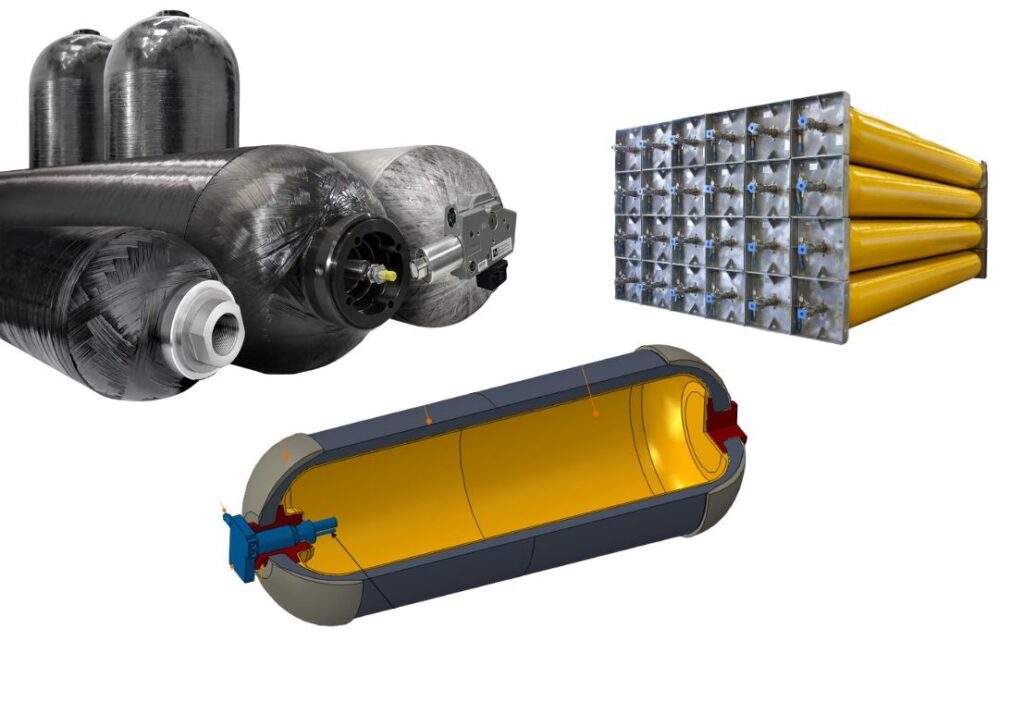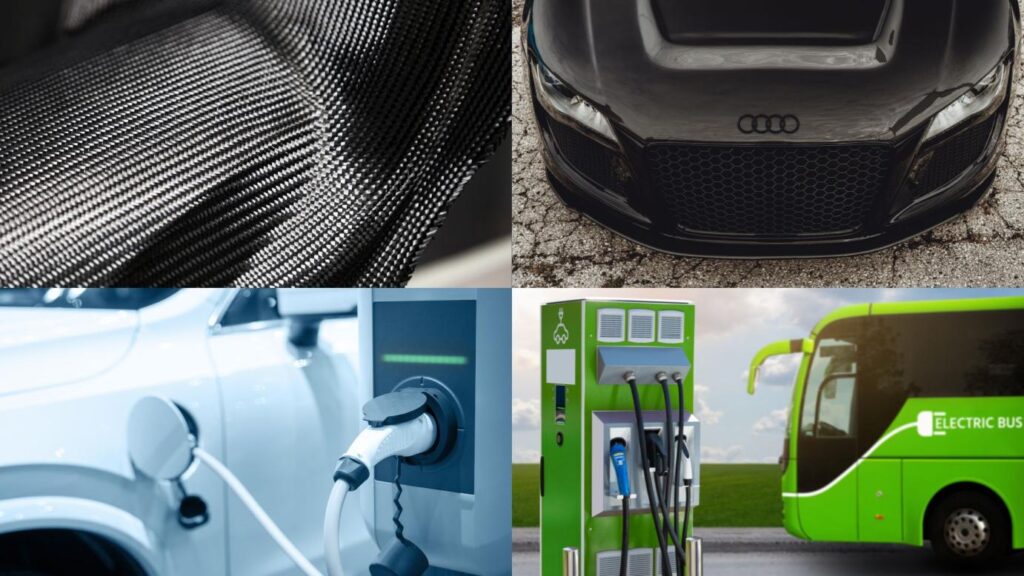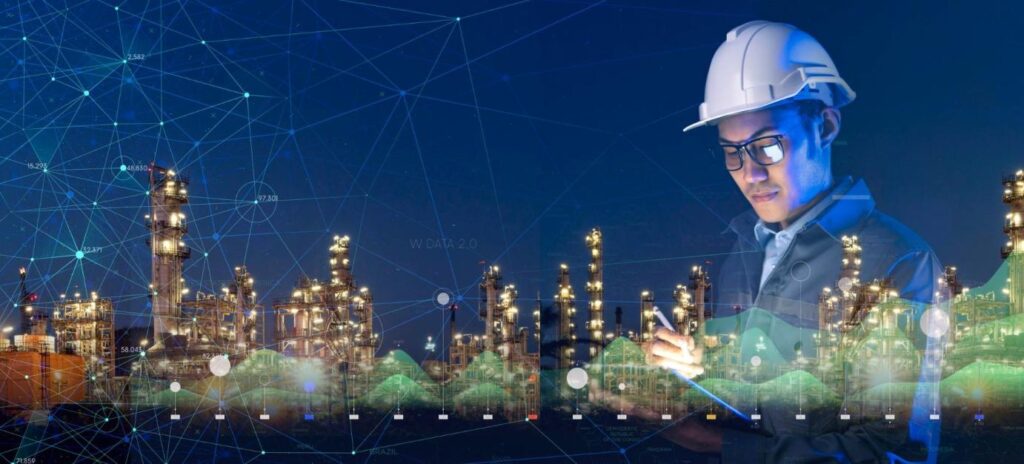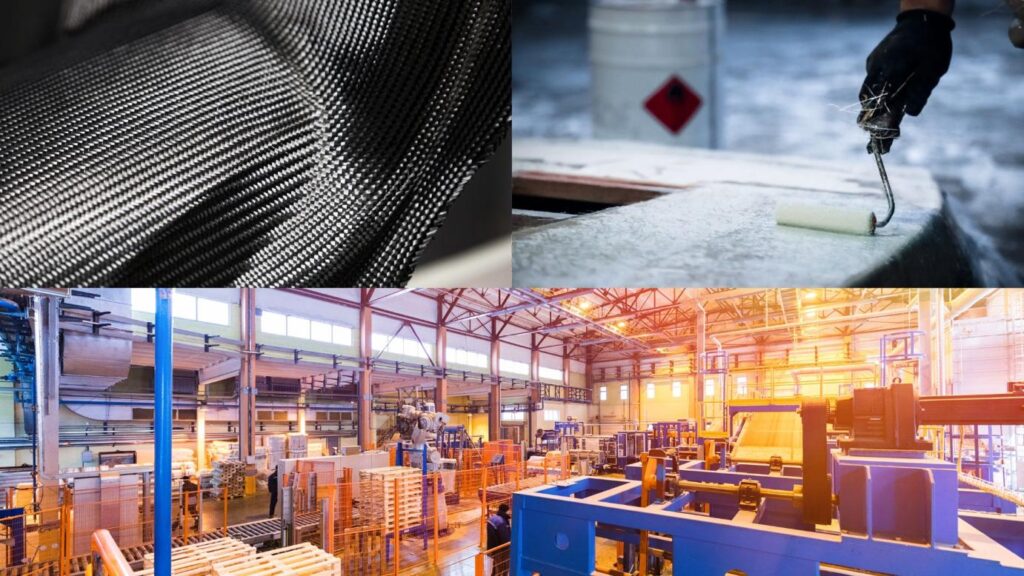Composite pressure vessels are rapidly transforming the gas storage and transportation industry, offering significant advantages over traditional metal tanks. These advanced containers combine lightweight materials with exceptional strength, making them ideal for a wide range of applications, from aerospace to renewable energy.
Key Advantages of Composite Pressure Vessels
Composite pressure vessels offer several compelling benefits compared to conventional metal tanks:
- Lightweight Design: Up to 70% lighter than steel tanks, reducing transportation costs and improving fuel efficiency
High Strength-to-Weight Ratio: Allows for greater storage capacity without increasing overall weight Corrosion Resistance: Extended lifespan and reduced maintenance requirements Customisable Design: Can be tailored to specific application needs and space constraints Improved Safety: More predictable failure modes compared to metal tanks
Applications Across Industries
The versatility of composite pressure vessels makes them valuable in numerous sectors: Aerospace and Space Exploration
- Satellite propulsion systems
- Spacecraft life support
- Rocket fuel storage
- Space station modules
Automotive and Transportation
- Hydrogen fuel cell vehicles
- Compressed natural gas (CNG) storage
- Alternative fuel transportation
Energy and Industrial
- High-pressure gas storage (hydrogen, natural gas, nitrogen)
- Renewable energy storage systems
- Industrial gas transportation
- Corrosive liquid storage
Healthcare
- Portable oxygen tanks
- Medical gas storage
Types of Composite Pressure Vessels
There are several types of composite pressure vessels, each with specific characteristics:
- Type 3: Metal liner with composite overwrap
- Best for: High-pressure gas storage
- Advantages: Excellent gas impermeability, high durability
- Type 4: Polymer liner with composite overwrap
- Best for: Lightweight applications
- Advantages: Significant weight reduction, corrosion resistance
- Type 5: Linerless all-composite
- Best for: Aerospace and extreme environments
- Advantages: Ultra-lightweight, highest performance potential
Manufacturing Processes
Advanced manufacturing techniques are key to producing high-performance composite pressure vessels:
- Filament Winding: Precise layering of fiber tows for optimal strength
- Automated Fiber Placement (AFP): Computer-controlled layup for complex geometries
- Resin Infusion: Ensures complete and uniform impregnation of fibers
Material Innovations
Ongoing research is focused on enhancing the performance of composite pressure vessels through material advancements:
- Carbon Fiber: Primary reinforcement material, offering exceptional strength-to-weight ratio
- High-Performance Epoxy Resins: Improved bonding and durability
- Nano-Enhanced Composites: Incorporating nanomaterials for further strength improvements
- Bio-Based and Sustainable Materials: Exploring eco-friendly alternatives
Market Growth and Future Outlook
The global market for composite pressure vessels is experiencing rapid growth:
- Composite cylinder market projected to reach $1.2 billion by 2030
Aerospace composite parts market expected to hit $87 billion by 2032High-pressure gas storage market estimated at $10 billion annually Driving factors include:
- Increasing demand for lightweight materials in transportation
- Growth of the hydrogen economy and renewable energy sector
- Expanding space exploration initiatives
Challenges and Ongoing Research
While composite pressure vessels offer numerous advantages, ongoing research addresses key challenges:
- Permeability: Improving gas barrier properties, especially for hydrogen storage
- Impact Resistance: Enhancing durability for terrestrial applications
- Cost Reduction: Developing more efficient manufacturing processes
- Standardization: Establishing uniform testing and certification procedures
Conclusion
Composite pressure vessels represent a significant leap forward in gas storage and transportation technology. Their lightweight design, exceptional strength, and versatility make them ideal for a wide range of applications, from powering the next generation of clean vehicles to enabling deep space exploration. As research continues and manufacturing processes improve, we can expect to see even more innovative uses for these advanced containers, driving progress across multiple industries. By choosing composite pressure vessels, companies can benefit from improved efficiency, reduced costs, and enhanced performance in their gas storage and transportation needs. As the technology continues to evolve, composite pressure vessels will play an increasingly crucial role in shaping a more sustainable and technologically advanced future.
Innovellix: Pioneering the Future of Space Exploration and Tourism
At Innovellix, we’re not just dreaming about the future of space exploration and tourism – we’re building it. With over 25 years of experience in composite materials and advanced manufacturing, our team of expert engineers and scientists is revolutionizing the way we approach space travel. Our groundbreaking technology is making space more accessible, safer, and more efficient than ever before.
Why Innovellix is Leading the Charge in Space Innovation
When it comes to space exploration and tourism, every gram matters. That’s where Innovellix’s expertise in ultralightweight, all-composite materials comes into play. Our innovative technology is transforming the space industry by:
- Reducing launch costs by up to 70% compared to traditional materials
- Enhancing spacecraft performance through superior strength-to-weight ratios
- Improving safety with more durable and reliable components
- Enabling new possibilities in spacecraft design and functionality
Let’s dive into how Innovellix is shaping the future of space travel and why our technology is the key to unlocking the stars.
The Innovellix Advantage: Ultralightweight Composite Pressure Vessels
At the heart of our space technology is our revolutionary ultralightweight, all-composite conformal pressure vessels. These aren’t your average fuel tanks – they’re a game-changer for the entire space industry. Here’s why:
- Unmatched Weight Reduction: Our pressure vessels are up to 70% lighter than traditional metal tanks. This dramatic weight reduction means spacecraft can carry more payload, travel further, or operate more efficiently.
- Superior Strength: Despite their lightweight nature, our composite vessels boast incredible strength. They can withstand the extreme pressures and temperatures of space travel without compromising structural integrity.
- Customizable Design: Unlike rigid metal tanks, our composite vessels can be molded into various shapes. This flexibility allows for more efficient use of space within spacecraft, potentially revolutionizing spacecraft design.
- Corrosion Resistance: In the harsh environment of space, corrosion can be a significant problem. Our composite materials are naturally corrosion-resistant, increasing the longevity and reliability of spacecraft components.
- Cost-Effective: Our innovative manufacturing process not only produces superior products but does so at a lower cost. This cost-effectiveness is crucial in making space exploration and tourism more accessible.
Applications in Space Exploration
Innovellix’s technology isn’t just theoretical – it’s already making waves in the space exploration sector. Here are some key applications:
Satellite Propulsion Systems
Our lightweight pressure vessels are ideal for satellite propulsion systems. They allow satellites to carry more fuel without increasing overall weight, extending mission durations and capabilities.
Spacecraft Life Support
In long-duration space missions, every bit of weight matters. Our composite tanks can store vital gases like oxygen more efficiently, potentially enabling longer missions or smaller, more maneuverable spacecraft.
Rocket Fuel Storage
The efficiency of our pressure vessels means rockets can carry more fuel while weighing less overall. This increased efficiency could lead to more powerful launches or the ability to reach more distant destinations.
Space Station Modules
Our technology isn’t limited to vessels – we’re also developing lightweight, strong materials for space station modules. These could make future space stations larger, more durable, and more cost-effective to launch and maintain.
Revolutionizing Space Tourism
Space tourism is no longer the stuff of science fiction – it’s becoming a reality, and Innovellix is at the forefront of making it accessible and safe for everyone. Here’s how our technology is paving the way for the average person to experience the wonders of space:
Lighter, More Efficient Spacecraft
Our ultralightweight materials mean space tourism vehicles can be lighter without compromising safety. This increased efficiency could lead to:
- Lower fuel costs, making trips more affordable
- Ability to carry more passengers per flight
- Extended flight durations for more comprehensive space experiences
Enhanced Safety Features
Safety is paramount in space tourism, and our composite materials offer several advantages:
- Superior impact resistance: Our materials can better withstand potential collisions with space debris
- Improved thermal management: Better insulation properties to protect passengers from extreme temperatures
- Radiation shielding: Potential for integrating radiation-resistant properties into our composites
Comfortable Interiors
Space tourists expect comfort, even in the challenging environment of space. Our lightweight materials allow for:
- More spacious interiors without increasing overall vehicle weight
- Integration of amenities and entertainment systems
- Better noise reduction for a more pleasant journey
Reusable Components
Sustainability is key to the future of space tourism. Our durable, corrosion-resistant materials are ideal for reusable spacecraft components, reducing costs and environmental impact over time.
The Science Behind Innovellix’s Space Technology
At Innovellix, we believe in the power of science and innovation. Our space technology is the result of years of research and development in materials science, structural engineering, and advanced manufacturing processes. Let’s break down the key scientific principles behind our revolutionary products:
Advanced Composite Materials
Our pressure vessels and other space components are made from advanced composite materials, primarily carbon fiber reinforced polymers (CFRPs). Here’s why they’re so effective:
- High strength-to-weight ratio: CFRPs are stronger than steel but much lighter, making them ideal for space applications.
- Customizable properties: We can adjust the fiber orientation and resin composition to optimize strength, stiffness, and other properties for specific applications.
- Thermal stability: Our composites maintain their properties across a wide range of temperatures, crucial for the extreme conditions of space.
Innovative Manufacturing Processes
Our manufacturing techniques are as cutting-edge as our materials:
- Automated Fiber Placement (AFP): This computer-controlled process allows for precise layup of carbon fiber tows, ensuring consistent quality and optimized fiber orientation.
- Resin Infusion: We use advanced resin infusion techniques to ensure complete and uniform impregnation of the carbon fibers, eliminating weak spots and air pockets.
- Out-of-Autoclave Curing: Our proprietary curing process eliminates the need for large, expensive autoclaves, reducing manufacturing costs and energy consumption.
Structural Optimization
We use advanced computer modeling and finite element analysis to optimize the design of our pressure vessels and other components:
- Topology optimization: This technique helps us determine the most efficient material distribution to maximize strength while minimizing weight.
- Stress analysis: We simulate various load conditions to ensure our components can withstand the rigors of launch and space environments.
- Thermal modeling: Our designs account for the extreme temperature fluctuations encountered in space.
Innovellix’s Commitment to Sustainability in Space
As we push the boundaries of space exploration and tourism, Innovellix is deeply committed to ensuring our activities are sustainable and environmentally responsible. Here’s how we’re working towards a greener future in space:
- Reducing Space Debris: Our lightweight, durable components are designed for longevity, reducing the amount of debris left in orbit.
- Eco-Friendly Manufacturing: Our manufacturing processes are optimized to minimize energy consumption and waste production.
- Recyclable Materials: We’re researching ways to make our composite materials more recyclable, aiming for a circular economy even in space.
- Efficient Resource Use: Our lightweight technology means less fuel is needed for launches, reducing the overall environmental impact of space activities.
- Sustainable Space Tourism: We’re developing technologies to make space tourism more environmentally friendly, including reusable components and cleaner propulsion systems.
The Future of Space with Innovellix
As we look to the future, Innovellix is committed to pushing the boundaries of what’s possible in space exploration and tourism. Here are some exciting developments on the horizon:
Next-Generation Spacecraft
Our advanced materials and manufacturing techniques are enabling the development of spacecraft that are:
- More efficient: Capable of longer missions with less fuel
- More versatile: Adaptable for various mission types, from orbital tourism to deep space exploration
- More comfortable: Providing a better experience for both astronauts and space tourists
Lunar and Martian Habitats
As humanity looks to establish a presence on the Moon and Mars, Innovellix’s technology will play a crucial role:
- Lightweight habitats: Our composite materials can create strong, spacious living quarters that are light enough to transport to other worlds
- Radiation shielding: We’re developing advanced composites that can protect inhabitants from harmful cosmic radiation
- Resource efficiency: Our technology can help create closed-loop life support systems, crucial for long-term off-world habitation
Orbital Manufacturing
The unique properties of our composite materials open up new possibilities for manufacturing in space:
- Zero-gravity fabrication: Our AFP technology could be adapted for in-space manufacturing, creating large structures impossible to launch from Earth
- On-demand parts: Future space stations or ships could use our technology to produce replacement parts as needed, increasing self-sufficiency
Advanced Propulsion Systems
Our lightweight pressure vessels are enabling the development of more efficient propulsion systems:
- Ion drives: Compact, efficient engines for long-duration missions
- Nuclear thermal propulsion: Safe, powerful systems for rapid interplanetary travel
Why Choose Innovellix for Your Space Ventures?
When you partner with Innovellix for your space exploration or tourism needs, you’re choosing:
- Expertise: Our team has decades of combined experience in composite materials and space technology.
- Innovation: We’re constantly pushing the boundaries of what’s possible in space travel.
- Quality: Our rigorous testing and quality control processes ensure the highest standards of safety and performance.
- Customization: We work closely with you to create solutions that meet your exact specifications.
- Support: Our dedicated customer service team is always ready to assist you, from initial design to ongoing maintenance.
Case Studies: Innovellix in Action
Revolutionizing Satellite Design
When a leading satellite manufacturer needed to reduce the weight of their next-generation communication satellites, they turned to Innovellix. Our team designed custom composite pressure vessels and structural components that reduced the overall weight of the satellite by 30%, allowing for increased payload capacity and extended mission duration.
Enabling New Horizons in Space Tourism
A pioneering space tourism company partnered with Innovellix to develop lightweight, safe passenger compartments for their suborbital vehicles. Our composite materials and innovative design increased passenger capacity by 25% while improving safety features, helping to make space tourism more accessible and enjoyable for civilian space travelers.
The Innovellix Process: From Concept to Launch
When you work with Innovellix, you benefit from our comprehensive approach to space technology development:
- Consultation: We meet with you to understand your specific needs and requirements for your space mission or vehicle.
- Design: Our engineers create custom designs optimized for your application, using advanced modeling and simulation tools.
- Prototyping: We produce and test prototype components to validate the design under space-like conditions.
- Manufacturing: Using our advanced facilities, we produce your components to the highest standards of quality and precision.
- Testing: Each component undergoes rigorous quality control and performance testing to ensure it meets or exceeds space industry standards.
- Integration: We work with your team to seamlessly integrate our components into your spacecraft or system.
- Support: Our team provides ongoing support throughout the lifecycle of your space mission or tourism operation.
Frequently Asked Questions
Q: How do Innovellix’s composite materials compare to traditional aerospace materials in terms of durability?
A: Our composite materials often outperform traditional aerospace metals in terms of durability, especially in the harsh environment of space. They resist corrosion, fatigue, and thermal stress better than many metals, potentially extending the lifespan of spacecraft components. Q: Can Innovellix’s technology be used for deep space missions?
A: Absolutely! Our lightweight, strong materials are ideal for deep space missions where every gram of weight matters. Our pressure vessels can store fuel and life-support gases more efficiently, potentially enabling longer missions or smaller, more maneuverable spacecraft. Q: How does Innovellix ensure the safety of its components for human spaceflight?
A: Safety is our top priority. We subject our components to rigorous testing that meets or exceeds industry standards. This includes pressure cycling, extreme temperature exposure, radiation resistance, and simulated launch conditions. We also work closely with space agencies and regulatory bodies to ensure compliance with all safety requirements. Q: Can Innovellix’s technology help reduce the cost of space launches?
A: Yes, significantly. Our lightweight components can reduce the overall weight of a spacecraft, which directly translates to fuel savings during launch. Additionally, our efficient manufacturing processes can lower the production costs of spacecraft components. Q: How is Innovellix addressing the issue of space debris?
A: We’re tackling space debris in several ways. First, our durable materials extend the lifespan of spacecraft, reducing the frequency of replacements. Second, we’re researching materials and designs that can be more easily de-orbited at the end of their life. Lastly, we’re exploring the use of our technology in active debris removal systems.









